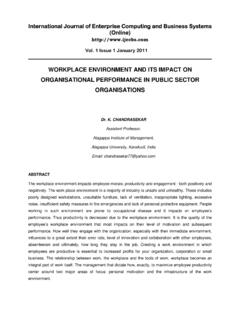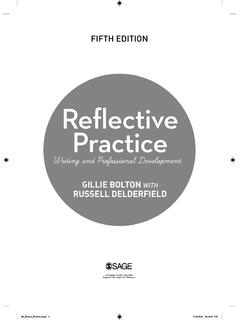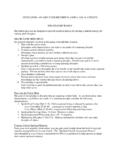Transcription of Community Psychology: Linking Individuals and Communities ...
1 IxCONTENTSP reface Community PsychologyChapter 1 The Fundamentals of Community Psychology: Promoting Social Change 1 What Is Community Psychology? 3 Individualistic Versus Structural Perspectives 6 Community Psychology: A Shift in Perspective 8 Persons, Contexts, and Change 9 Persons and Contexts 9 Structural Perspectives and First-Order and Second-Order Change 11 Ecological Levels of Analysis in Community Psychology 15 Individuals 17 Microsystems 17 Organizations 18 Localities 18 Macrosystems 19 Levels of Intervention 20 Eight Core Values in Community Psychology 22 Social Justice 25 Respect for Human Diversity 25 Sense of Community 26 Collective Wellness 26 Empowerment and Citizen Participation 27 Collaboration 27 Empirical Grounding 28 Multilevel, Strengths-Based Perspective 28 The Interrelationship of Community Psychology Values 28 Overview of This Book 30 Using Respectful Language to Discuss Social Identities 30 Learning Goals 31 Copyright American Psychological AssociationxConTenTSChapter 2 The Development and Practice of Community Psychology 33 Community Psychology as a Linking Science and a Linking Practice 35 The Practice of Psychology in the 20th Century 36 Individualistic Practice 37 Psychology in Cultural Perspective 38 The Formative Contexts of Community Psychology 39 The Growth of Psychology After World War II 39 Preventive Perspectives on Problems in Living 41 Reforms in Mental Health Systems 42 Group Dynamics and Action Research 45 Movements for Social Change and Liberation 47 Undercurrents of Optimism 50 Community Psychology.
2 Developing an Identity 51 The Swampscott Conference 51 Establishing a Field of Community Psychology 52 Community Psychology in Shifting Social Contexts 53 Societal Shifts Toward Individual-Level Conceptualization of Social Problems 54 Emergence of Globalization as a Movement 55 Defining Social Issues in Progressive and Conservative Eras 56 Developing New Conceptual Frameworks to Inform the Practice of Community 58 Addressing Social Issues and Equity 58 Bottom-Up and Top-Down: Contrasting Approaches to Social Change 61 Diversity of Viewpoints, Divergent Reasoning, and Dialogue 62 What Do Community Psychologists Do? 63 Training for Community Psychology 63 Community Psychology Practice 64 Community Psychology Practice Skills 65 Ethics in Community Psychology 69 The Global Contexts of Community Psychology 70 Unique Development in Different Contexts 71 Community Psychology in North America 71 Community Psychology in Latin America 72 Community Psychology in Europe, Australia, and New Zealand 73 Copyright American Psychological AssociationConTenTS xiCommunity Psychology in Africa 74 Community Psychology in Asia 75 Moving Toward Global Dialogues in Community Psychology 76 Conclusion 77II.
3 Community ResearchChapter 3 The Aims of Community Research 80 Action Research in Community Psychology 81 Community Research Practice: Shared Commitments in Contextually Grounded Inquiry 83 Examining the Values and Assumptions We Bring to Our Work 84 Three Philosophies of Science for Community Psychology Research 84 Problem Definition in Research 88 Attending to Marginalized Voices 89 Promoting Community Participation and Collaboration in Research Decisions 91 Developing a relationship Before the Beginning 93 Research Decisions: Defining the Topic and Collecting Data 95 Interpreting Findings 96 Reporting Research and Evaluating Its Impact 97 Ethics of Participatory Approaches 101 Attending to the Cultural and Social Contexts of Research 102 Three Methodological Issues Involving Culture 102 Conducting Culturally Anchored Research 105 Conducting Research With an Ecological Perspective 107An Example of the Importance of Considering Levels of Analysis: Supported Housing Environments 107 How Can Ecological Levels Be Studied?
4 108 Conclusion 109 Chapter 4 Methods of Community Psychology Research 111 Answering Research Questions in Community Psychology 113 Qualitative Methods 113 Participant Observation 116 Qualitative Interviewing 117 Focus Groups 118 Copyright American Psychological Associationxii ConTenTSCase Studies 119 Two Concluding Issues 122 Quantitative Methods 124 Common Features of Quantitative Methods 125 Quantitative Description and Inference 126 Randomized Field Experiments 130 Nonequivalent Comparison Group Designs 132 Interrupted Time-Series Designs 134 Mixed-Methods Research 137 Combining Participatory Methods and GIS Mapping to Understand Community 138A Mixed-Methods Evaluation of Peer Support for Early Adolescents 138A Mixed-Methods Evaluation of the Sexual Assault Nurse Examiner Program 140 Conclusion 141 III. Understanding CommunitiesChapter 5 Understanding Individuals Within environments 144 Conceptual Models of Ecological Context 147 Four Ecological Principles 147 Social Climate Dimensions 152 Social Regularities 154 Ecological Psychology and Behavior Settings 155 Activity Settings 158 Environmental Psychology 161 Comparing the Six Perspectives on Ecological Context: An Example 163 The Importance of Understanding Ecological Contexts for Intervention 166 Research: Linking Neighborhoods, Families, and Individuals 166 Promoting Neighborhood Quality of Life 171 Creating and Altering Settings 172 The Community Lodge: Creating an Alternative Setting 172 Conclusion: Promise and Challenges of Changing Environments 176 How Are Contexts Both Powerful and Fragile in Their Influences on Individuals ?
5 176 How Can We Understand Ecological Contexts as Dynamic Systems That Change Over Time? 177 Copyright American Psychological AssociationConTenTS xiiiHow Can We Clarify the Mutual Relationships Between Individuals and Contexts? 177 How Are Ecological Contexts Influenced by Culture, Ethnicity, Gender, and Other Social Processes? 177 Chapter 6 What Defines Community ? 179An Ecological-Transactional Model of Communities 180 What Is a Community ? 181 Types of Communities 182 Levels of Communities 183 Who Defines Communities ? 184 Sense of Community 185 Benefits of a Sense of Community 186 Four Elements of Sense of Community 188 Questions and Issues for Defining and Measuring Sense of Community 191 Concepts Related to Sense of Community 192 The Complex Realities of Communities 194 Counterspaces 196 Multiple Communities in a Person s Life 198 Conflict and Change Within a Community 199 Respect for Diversity and Sense of Community 201 The Importance of Community 202 Social Capital 202 building Communities 206 The Physical and Natural Environments 207 Sense of Community Online 209 Hope, Spirituality, and Transcendence in Relation to Sense of Community 211 Conclusion 213 Chapter 7 Understanding Human Diversity in Context 214 Fostering Brave Spaces: An Invitation to Engage In Diversity Conversations With Courage and Humility 215 What Is Human Diversity?
6 216 Intersectionality: A Tool for Understanding Human Diversity 217 Key Dimensions of Human Diversity for Community Psychology 218 Culture 219 Race, Ethnicity, Gender, and Social Class 220 Dimensions of Diversity Receiving Greater Attention in Community Psychology 224 Social Inequities 229 Copyright American Psychological Associationxiv ConTenTSExperience of Culture and Dimensions of Diversity: Socialization in Cultural Communities 229 Revitalizing Activity Settings in an Alaska Native Community 230 Developing Counterspaces as Activity Settings 231 Identity Development and Acculturation 232 Identity Development Models 232 Acculturation Models 235 Psychological Acculturation 236 The Need for a Contextual Perspective in Acculturation 238 Concepts of Liberation, Oppression, and Decoloniality 240 Oppression: Initial Definitions 241 Oppression: Multiple Ecological Levels 244 The Liberation Perspective: A Call to Action 248 Attending to Diversity in the Practices of Community Psychology 250 Cultural Competence Across Levels of Analysis 250 When Values of Diversity and Community Conflict 251 When Culture and Liberation Conflict 252 Designing Culturally Anchored Community Programs 254 Conclusion 254IV.
7 Collective and Community Responses to ChallengesChapter 8 empowerment and Citizen Participation 257 What Is Empowerment? 259 The Context and Limits of Empowerment 260 What Is Citizen Participation? 261 Citizen Participation in Action 263 Citizen Participation: A Means or an End? 265 Multiple Forms of Power 266 Power Over, To, and From 266 Integrative Power 268 Three Instruments of Social Power 269 Summary Thoughts on Power 274 How Do Citizens Become Empowered Leaders in Their Communities ? 275 Personal Qualities for Citizen Participation and Empowerment 277 Sense of Community and Citizen Participation in Neighborhood Organizations 281 Copyright American Psychological AssociationConTenTS xvEmpowering Practices and Settings 282 Empowering Practices 283 Empowering and Empowered Community Settings 283 Family Violence Coordinating Councils as Empowering Contexts 284 Highlander Research and Education Center: An Empowering Setting 285 Riot Youth: An LGBTQ+ Theater Group 286 Features of Empowering Practices and Settings 287 Conclusion 292 Chapter 9 Understanding Stress and Coping in Context 294 Stress and Coping.
8 An Ecological-Contextual Model 296 Risk and Protective Factors 297 Distal and Proximal Factors 300 Working Through the Ecological-Contextual Model 301 Distal Personal Factors 303 Proximal Stressors 303 Resources Activated for Coping 310 Coping Processes 311 Coping Outcomes 314 Interventions to Promote Coping 317 Social Support 322 Generalized and Specific Support 323 The relationship Context of Support 323 Social Support Networks 325 Mutual Help Groups 326 Distinctive Features of Mutual Help Groups 327 Online Mutual Help 329 Mutual Help Outcomes 330 Spirituality and Coping 331 Empirical Research on Spirituality and Coping 333 Conclusion 334V. Preventing Problems and Promoting Social CompetenceChapter 10 Key Concepts in the Science of Prevention and Promotion 337 Prevention and Promotion Are All Around You 338 What Is Prevention? 340 Copyright American Psychological Associationxvi ConTenTSWhat Is Promotion?
9 341 Concepts for Understanding Prevention and Promotion 341 Primary, Secondary, and Tertiary Prevention 341 Universal, Selective, and Indicated Preventive Measures 342 Prevention of Disorder and Promotion of Wellness and Competence 343 Promotion of What? building Resiliency 345 Putting It All Together: Addressing Risk and Protective Factors on a Community Level 349 Applying Knowledge of Risk and Protective Factors in Your Community 351Do Prevention Programs Work? 355 Meta-Analyses of Prevention Programs 355 Are Prevention Programs Cost-Effective? 357 Examples of Successful Prevention and Promotion Programs 360 Prevention of HIV/AIDS Infection: Promoting Healthy Sexual Behaviors 361 Prevention of Childhood Behavior Disorders: Promoting Positive Parenting 364 Prevention of Bullying and School Violence: Promoting Safe School Climates 366 The Implementation and Sustainability of Programs 369 Chapter 11 Implementing Prevention and Promotion Programs 372 Introduction to Prevention.
10 Program Implementation Is Challenging 373It s Not Just Program Implementation, It s Program Innovation 375A Brief History of Approaches to Program Implementation 376An Integrative Model 378 Elements of Successful Implementations 382 Evaluation as a Means to Better Implementation 383 Community -Based Participatory Action Research in Program Implementation 385 Evaluate for Unintended Consequences 386 Examples of Successful Dissemination 387 Social-Emotional Learning Programs 387 Home-Visiting Programs 390 Applying What We Know in Program Implementation 392 Copyright American Psychological AssociationConTenTS xviiProblem Identification and Definition 392 Assessment of the Setting 393 Reviewing Available Interventions 395 Assessing the Fit Between the Program and the Setting 399 Training and Support of Staff 400 Implementing, Innovating, and Sustaining Programs 401 Cultural Diversity in Program Implementation 403 Suicide Prevention Program in Native American/Alaska Native Communities 404 Putting It All Together 406 Chapter 12 Program Development, evaluation, and Improvement 408 Evaluation in Everyday Life 410 Rationale for Program Evaluation 411It Seemed Like a Good Idea, but Is It Really Working?
















